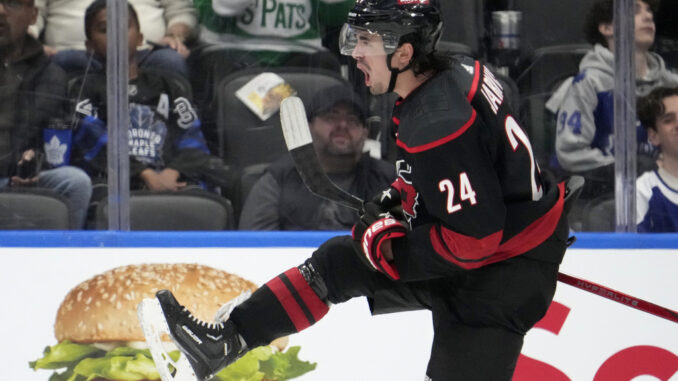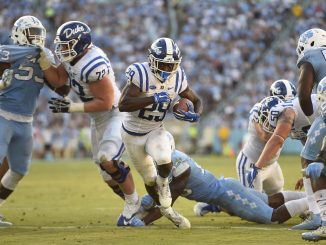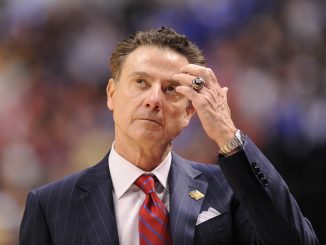

RALEIGH — Seth Jarvis picked the perfect time to have his breakout season.
The Hurricanes’ 22-year-old right wing saw his six-game goal streak come to an end Sunday in a 2-1 win against visiting Toronto, but he’s still put together a brilliant third season. Through 72 games, Jarvis has 27 goals and 30 assists for 57 points, is a top penalty-killing forward and plays on the team’s No. 1 power play.
All that sets up Jarvis, in the final season of his three-year entry-level contract, for a big payday.
Jarvis will not have arbitration rights this summer, but his play gives him leverage. While Carolina would certainly like to lock Jarvis up to an eight-year deal — as the team did with Andrei Svechnikov and Jesperi Kotkaniemi before either reached arbitration eligibility — he may want to bet on himself with a bridge deal that would pay him less now but could set him up for a bigger payout in two or three years.
What could a new deal for Jarvis look like? Let’s break it down.
Long-term deal
A good way to find a starting point for pricing Jarvis’ next contract is to look at similarly aged players and the deals they’ve received.
One comparable is Wild winger Matthew Boldy, who is in the first season of a seven-year, $49 million contract. Boldy was the 12th overall pick by Minnesota in 2019 — one year before Jarvis was picked 13th by Carolina — and put up 31 goals and 32 assists in the final season of his ELC.
Boldy benefited from having the first season of his initial three-year deal burned in 2020-21 by playing 14 games with the Wild’s AHL affiliate. He also signed his extension in late January 2023, before he had a 12-goal, 17-point March that would’ve likely further boosted his $7 million annual cap hit.
Montreal’s Cole Caufield, drafted seven picks after Boldy in 2019, is also a reasonable benchmark for Jarvis. The Canadiens’ diminutive winger scored 53 goals and 84 points in his first 123 NHL games, and he signed an eight-year contract with a $7.875 annual cap hit last summer.
Compatively, Jarvis has 58 goals, 78 assists and 136 points in 222 career games with 10 games remaining in the season.
The Boldy deal counted for 8.48% of the NHL’s cap ceiling at the time of its signing, according to CapFriendly.com, while Caufield’s deal came in at 9.52%.
That’s significant because the NHL’s salary cap is expected to be $87.7 million next season, climbing $4.2 million.
Unless Jarvis’ point production dries up in the season’s final 10 games, he and his agent should be able to claim that he outperformed both Boldy and Caufield during their ELCs. As mentioned, the salary cap will also be going up — and that factors into negotiations.
Boldy’s deal being seven years instead of eight brings down its cost since that eighth year is a season during which the player could be an unrestricted free agent.
If the Hurricanes can get Jarvis to consider an eight-year deal — and I’m sure that’s the organization’s preference if the price is right — they’d probably like to keep him under Svechnikov’s $7.75 million AAV. Jarvis’ camp probably sees $8.35 million as a reasonable ask.
Is there a middle ground, whether it’s a compromise on the AAV or taking it down to seven years?
Bridge deal
Let’s say the two sides can’t agree on a long-term deal. Enter a bridge deal. A bridge deal buys a team time before committing to a long-term deal while also allowing the player to bet on himself and perhaps land an even bigger extension down the road.
So what might that look like for Jarvis?
Anaheim’s Trevor Zegras, the ninth overall pick in 2019, had 49 goals and 139 points in 180 games during his first three NHL seasons. He had back-to-back 20-goal, 60-point seasons the last two years and, after prolonged negotiations, inked a three-year $5.75 million bridge deal with the Ducks before this season.
Going a little further back, Elias Pettersson had 66-, 68- and 66-point seasons in his first three years with Vancouver and was rewarded with a three-year, $7.35 million bridge deal before the 2021-22 season. He then parlayed that into a new eight-year, $11.6 million contract that will kick in next season.
Zegras’ contract has a cap ceiling percentage of 6.89%, while Pettersson’s was 9.02%, and at next year’s $88.7 million cap, that would put the range at just over $6.1 million to $7.9 million.
Neither of those is very palatable, but it is worth mentioning that both are centers, which usually land bigger contracts. The Hurricanes could get that number lower with a two-year bridge deal, perhaps pushing Jarvis into the $5 million range. But is it worth saving perhaps $3 million annually for two years if Jarvis’ third contract costs $2 million or more extra from what the long-term deal would cost now?
No matter the direction the two sides go, the Hurricanes are going to have to shell out big money to keep their rising star.



